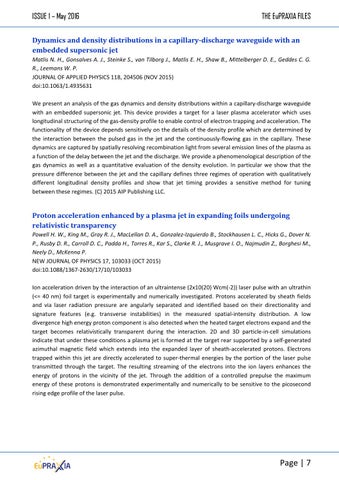ISSUE 1 – May 2016
THE EuPRAXIA FILES
Dynamics and density distributions in a capillary‐discharge waveguide with an embedded supersonic jet Matlis N. H., Gonsalves A. J., Steinke S., van Tilborg J., Matlis E. H., Shaw B., Mittelberger D. E., Geddes C. G. R., Leemans W. P. JOURNAL OF APPLIED PHYSICS 118, 204506 (NOV 2015) doi:10.1063/1.4935631 We present an analysis of the gas dynamics and density distributions within a capillary‐discharge waveguide with an embedded supersonic jet. This device provides a target for a laser plasma accelerator which uses longitudinal structuring of the gas‐density profile to enable control of electron trapping and acceleration. The functionality of the device depends sensitively on the details of the density profile which are determined by the interaction between the pulsed gas in the jet and the continuously‐flowing gas in the capillary. These dynamics are captured by spatially resolving recombination light from several emission lines of the plasma as a function of the delay between the jet and the discharge. We provide a phenomenological description of the gas dynamics as well as a quantitative evaluation of the density evolution. In particular we show that the pressure difference between the jet and the capillary defines three regimes of operation with qualitatively different longitudinal density profiles and show that jet timing provides a sensitive method for tuning between these regimes. (C) 2015 AIP Publishing LLC.
Proton acceleration enhanced by a plasma jet in expanding foils undergoing relativistic transparency Powell H. W., King M., Gray R. J., MacLellan D. A., Gonzalez‐Izquierdo B., Stockhausen L. C., Hicks G., Dover N. P., Rusby D. R., Carroll D. C., Padda H., Torres R., Kar S., Clarke R. J., Musgrave I. O., Najmudin Z., Borghesi M., Neely D., McKenna P. NEW JOURNAL OF PHYSICS 17, 103033 (OCT 2015) doi:10.1088/1367‐2630/17/10/103033 Ion acceleration driven by the interaction of an ultraintense (2x10(20) Wcm(‐2)) laser pulse with an ultrathin (<= 40 nm) foil target is experimentally and numerically investigated. Protons accelerated by sheath fields and via laser radiation pressure are angularly separated and identified based on their directionality and signature features (e.g. transverse instabilities) in the measured spatial‐intensity distribution. A low divergence high energy proton component is also detected when the heated target electrons expand and the target becomes relativistically transparent during the interaction. 2D and 3D particle‐in‐cell simulations indicate that under these conditions a plasma jet is formed at the target rear supported by a self‐generated azimuthal magnetic field which extends into the expanded layer of sheath‐accelerated protons. Electrons trapped within this jet are directly accelerated to super‐thermal energies by the portion of the laser pulse transmitted through the target. The resulting streaming of the electrons into the ion layers enhances the energy of protons in the vicinity of the jet. Through the addition of a controlled prepulse the maximum energy of these protons is demonstrated experimentally and numerically to be sensitive to the picosecond rising edge profile of the laser pulse.
Page | 7
